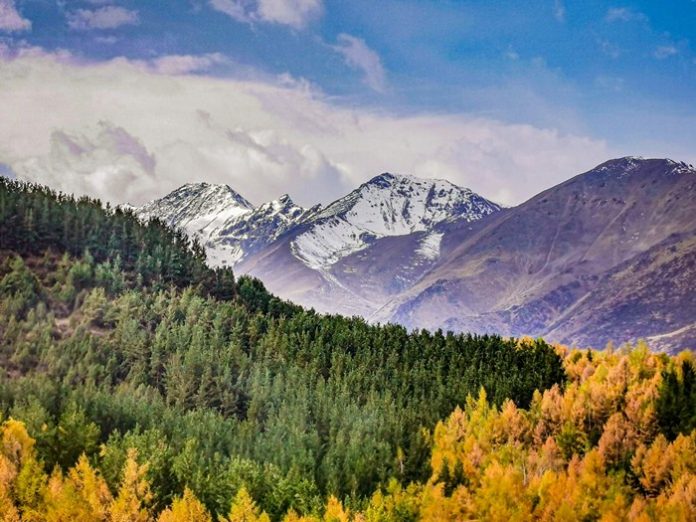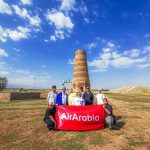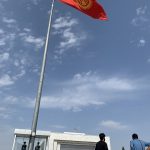Going from the summer heat, stifling humidity and dust storms of Kuwait to the balmy weather invigorating air and picturesque landscape of Kyrgyzstan was like traveling to an entirely different world.
We were in Bishkek, the capital of Kyrgyzstan as part of a familiarization trip organized by Air Arabia, the Middle East and North Africa (MENA) region’s first and largest Low Cost Carrier (LCC). Established in 2003, Air Arabia is now a major airline in the region and flies to over 170 destinations across the Middle East, North Africa, Asia and Europe.
Unlike many other LCC flights, the spacious seating, the range of amenities onboard the flight, the timely arrival and departures, and a generous 10kg carry-on baggage allowance, had me wondering why many other full-fare airlines did not pursue the Air Arabia model.

Air Arabia offers very convenient flights to Kyrgyzstan from Kuwait four times a week through their hub in Sharjah International Airport. The wide choice in flights and time schedules means that everyone can plan a convenient itinerary to Kyrgyzstan on Air Arabia. If you are looking for a quick weekend getaway, then Air Arabia has a convenient flight out of Kuwait on Thursday at 4.30pm which arrives in Bishkek on Friday at 3.00am local time, with a two-hour stopover and connection flight from Sharjah. The return flight on Sunday, leaves Bishkek at 4.00am and you are back in Kuwait by 9.00am, just in time to head back to the office for a working day.

In addition to the convenient flights on Air Arabia, Kyrgyzstan also has one of the most liberal tourist visa policies in Central Asia, and nationals of many countries are offered a visa on arrival at Bishkek. So it was no surprise that our flight from Sharjah to Bishkek was packed with holiday-makers eager to sample the country that has been hailed as the Switzerland of Central Asia.
The refreshing morning breeze that greeted us at Manas International Airport in Bishkek was probably an introduction to the pristine environment that we were promised awaited us during our short weekend visit to Kyrgyzstan in late September. Our travel in Kyrgyzstan was coordinated by Air Arabia’s partner Kyrgyz Concept, a company that prides itself on being a one-stop shop for all your travel needs in Kyrgyzstan.
Our first day in the Kyrgyz capital was spent in a tour of the city and a sampling of the famed Kyrgyz cuisine. From shorpa, a type of mutton soup, to Beshbarmak, a serving of large flat noodles topped with lamb or sometimes meat cooked in vegetable broth, and on to Azu, theTatar dish of meat fried with pickles and vegetables, the preponderant role of meat in the dishes was obvious.

The next day we headed to the Issyk Kul Lake region, around 270 km from Biskek and a nearly five-hour journey by road. Picture-book mountainscapes, rolling ‘jailoos’ or summer pastures, meandering pathways along pristine valleys, bordered by towering mountains and dotted with crystal clear mountain lakes greeted us as we made our way to the Lake region.
On the way we took a detour to visit the Burana Tower an ancient minaret, recognised as a UNESCO World Heritage Site. Located in the Chuy Valley about 80 km east of Bishkek, near the town of Tokmok, the tower, along with grave markers, some earthworks and the remnants of a castle and three mausoleums, is all that remains of the ancient city of Balasagun, which was established by the Karakhanids at the end of the 9th century. An external staircase and steep, winding stairway inside the tower enables visitors to climb to the top.
Then we continued our scenic drive through Boom Gorge canyon along the Chu River with views of the mountains in the distance before arriving in Issyk-Kul Lake area.
Issyk-Kul is the world’s second largest alpine lake after Lake Titicaca in South America. It is also the seventh deepest lake in the world at 670 meters and the tenth largest lake in the world by volume, as well as the second largest saline lake after the Caspian Sea. Although it is at an elevation of over 1,600 meters and surrounded by snow-capped peaks, the lake never freezes, and hence its name Issyk-Kul or ‘hot lake’ in Kyrgyz.

The lake itself is surrounded by protected marshlands, two mountain ranges, and many archaeological remains, from the petroglyphs in Cholpon-Ata to remains of buildings and cities that lie under the waters of the lake. The shores of Issyk-Kul were once well populated, and were famous among travelers and merchants who plied the ancient Silk Route. On the southern shore of Issyk-Kul is the picturesque village of Bokonbaevo, which is the center of ecological tourism in Kyrgyzstan. The area is also well known for its many resorts and spas, which together with the superb sights, make the region one of the most popular in Kyrgyzstan.
On the return trip to Bishkek we visited the Grigoreva Gorge with the gentle slopes of the valley covered with a dense fir forest and the sweet smell of pine trees pervading the air. The Gorge, is considered one of the most picturesque in Issyk Kul area. We had time to go for a boat ride in the placid waters of the lake before taking a horse-back ride in the fresh outdoors.
Back in Bishkek, we took off to visit the famed Chunkurchak Gorge, one of the smallest yet most beautiful gorges in Kyrgyzstan. Located about 45km from Bishkek, along the upper Alamedin River, the territory of the gorge lies in the National Biological Reserve that was setup to conserve the rare species of tulips. A visit to the Supara Chunkurchak Ethno Complex also provided us with an opportunity to learn about the culture of Kyrgyz nomad people.

Kyrgyzstan is a nation defined by its natural beauty that has been preserved in its pristine state as tourist hordes have not begun descending on the country. It is not difficult to see why the country has been the gateway of choice for many travelers visiting Central Asia. We would like to thank Air Arabia and Kyrgyz Concept for providing us with the opportunity to visit this amazingly scenic wonderland.

























